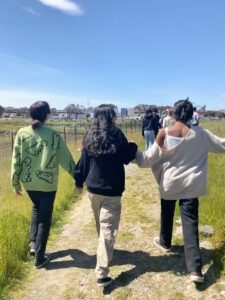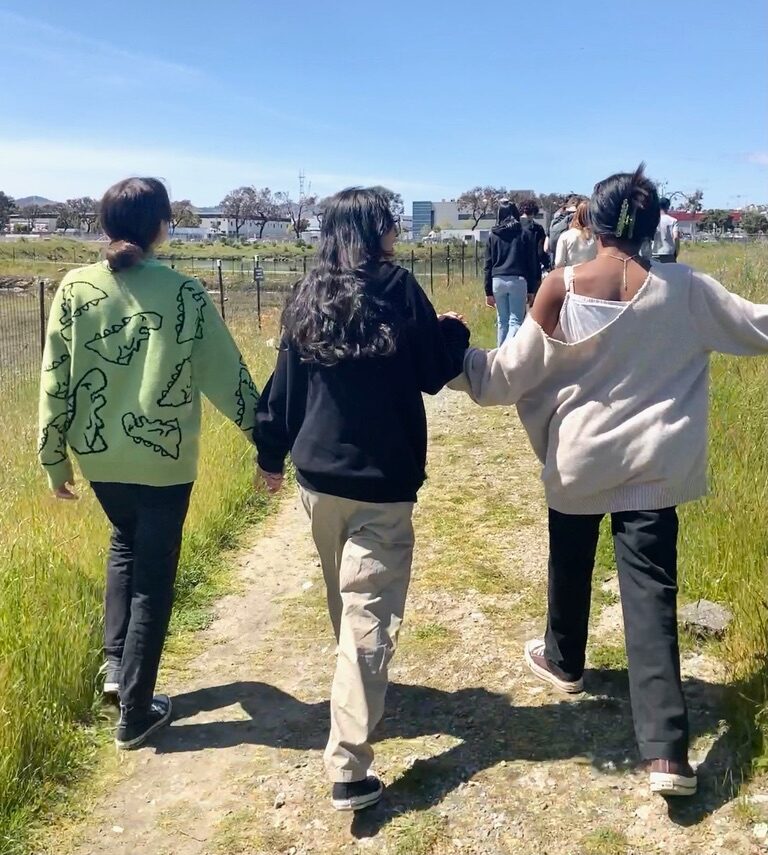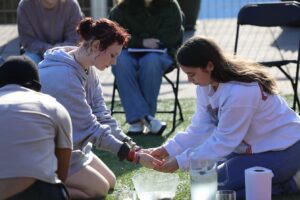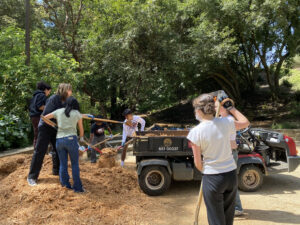As an introduction to the Public Purpose Program (PPP) at Lick-Wilmerding High School, frosh students participate in a volunteer program to weed and maintain Heron’s Head Park — located in the Bayview — on the two designated PPP days in April every year. This annual field trip began long before the COVID-19 pandemic and was reinstated into the LWHS Biology curriculum during the 2022-23 school year. This opportunity provides frosh students with an interactive learning experience by taking in-classroom learning into their wider San Francisco community.
Prior to the field trip, the students researched various aspects of the park in their biology classes, including the history and location, the Pacific Flyway (a major North American migration route for birds) estuaries, the PG&E power plant and more. Their research provided them with ample background knowledge about the park and the purpose of their expedition: to help weed and exterminate invasive species from Heron’s Head and maintain an influential part of the Bayview Hunter’s Point (BVHP) neighborhood for decades.
The park, named after its birds-eye view resemblance to a heron’s head, was previously a dumping ground for toxic waste.
The PG&E power plant, built in 1928, was the primary polluter in the BVHP neighborhood. Hunter’s Point, a predominantly Black community and home to many other racial and ethnic minorities, has historically had fewer restrictions on environmental laws to protect the land and monitor residents’ health.
Local environmental activists led a series of peaceful protests to shut down the power plant in the late 1990s after residents began noticing abnormal rates of various health impacts in the neighborhood, such as twice the average rate of asthma, cervical and breast cancer. Although there was no concrete proof that connected these effects back to the power plant, the Hunter’s Point community blamed these maladies on the toxic waste dumping plant.
As a result, 5000 tons of waste were removed in 1998 to transform the land into a public park that is now home to TheEcoCenter, an environmental education classroom, and various species of plants and migrating birds.
It wasn’t until the state proposed to erect another power plant that residents took direct action to eradicate the problem from their neighborhood. Willie Brown, San Francisco’s mayor at the time, led BVHP residents to combat the construction of another plant and encouraged the community to participate in peaceful protests to raise awareness about environmental racism.
In 1998, the city responded to the protests by agreeing to shut down the plant, but it wasn’t until 2006 that city officials followed through with their promise.
Since the power plant’s cessation, volunteers and city officials have worked tirelessly to transform the land into the beautiful wildlife preserve that stands today. Thousands of birds pass through the park while migrating to more hospitable climates. Within the past few months, San Francisco’s Recreation and Park department has also begun protecting spaces at Heron’s Head for native plants to grow.
The Recreation and Parks department also encourages volunteers to help preserve the land and weed out invasive species. Carissa Ortega, who works at the San Francisco Recreation and Parks department, explained that a group of volunteers could perform a week’s worth of gardening in only a few hours.

photo courtesy of @lwhslife Instagram
Two frosh students, Ruby Kilar ’26 and Maggie Buchholz ’26, reflected on their field trips to Heron’s Head in relation to their introduction to PPP work.
Researching and visiting Heron’s Head Park for Lick’s most recent PPP days helped me to understand the ideas and values that drive our Public Purpose Program. The research and discussions centered around our responsibility to understand the historical background of San Francisco (and beyond), the role of environmental justice and what we can be doing to better support our community and hold individuals accountable for damaging the environment.
by Ruby Kilar
My experiences at Heron’s Head Park illustrated the impact a community can have on their environment, which can impact their health and way of life. Seeing a part of the city where I live that has been beautified by its community has renewed my understanding of PPP’s purpose of giving back in our own neighborhoods. I realized how much we each truly can make a difference, even and especially when we start small. We have the power to influence and create the world we want.
by Maggie Buchholz
For students and teachers alike, Heron’s Head Park provides volunteers with an opportunity to actively participate in a rewarding cause. The maintenance work not only supports the healthy growth of plants and animals, but also actively combats environmental racism in the BVHP neighborhood. The field trip allows frosh students to experience the hands-on learning that proudly resides within LWHS’ core mission and provides a memorable introduction to LWHS’ Public Purpose Program.







рабочий промокод 1хбет https://kris.by/mouth/pages/promokod__260.html
1хбет промокод на сегодня http://tpor.ru/news/1hbet_promokod_pri_registracii__bonus_do_32500_rub_.html
рабочий промокод 1хбет бонус https://armatura-paz.ru/media/pgs/?1hbet_promokod_pri_registracii__bonus_do_32500_rub_.html
рабочий промокод 1xbet на сегодня https://kvin-tur.ru/content/pags/besplatnuy_promokod_pri_registracii.html